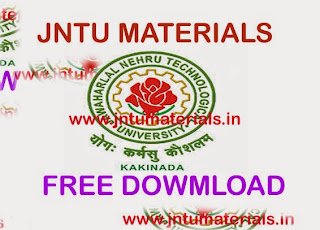JNTUK B.Tech R20 1-1 Sem Applied Physics Materials download is now available, the candidates who are looking for good material can download from here
Unit-I: Wave Optics
Interference: Principle of superposition –Interference of light - Interference in thin films (Reflection Geometry) & applications - Colors in thin films- Newton’s Rings- Determination of wavelength and refractive index.
Diffraction: Introduction - Fresnel and Fraunhofer diffraction - Fraunhofer diffraction due to single slit, double slit - N-slits (Qualitative) – Diffraction Grating - Dispersive power and resolving power of Grating(Qualitative).
Polarization: Introduction-Types of polarization - Polarization by reflection, refraction and Double refraction - Nicol’s Prism -Half wave and Quarter wave plates.
Download UNIT-I Material Here
Unit-II: Lasers and Fiber optics
Lasers: Introduction – Characteristics of laser – Spontaneous and Stimulated emissions of radiation – Einstein’s coefficients – Population inversion – Lasing action - Pumping mechanisms – Ruby laser – He-Ne laser - Applications of lasers.
Fiber optics: Introduction –Principle of optical fiber- Acceptance Angle - Numerical Aperture -Classification of optical fibers based on refractive index profile and modes – Propagation of electromagnetic wave through optical fibers - Applications.
Download UNIT-II Material Here
Unit III: Quantum Mechanics, Free Electron Theory and Band theory
Quantum Mechanics: Dual nature of matter – Heisenberg’s Uncertainty Principle – Significance and properties of wave function – Schrodinger’s time independent and dependent wave equations– Particle in a one-dimensional infinite potential well.
Free Electron Theory: Classical free electron theory (Qualitative with discussion of merits and demerits) – Quantum free electron theory– Equation for electrical conductivity based on quantum free electron theory- Fermi-Dirac distribution- Density of states (3D) - Fermi energy.
Band theory of Solids: Bloch’s Theorem (Qualitative) - Kronig - Penney model (Qualitative)-
E vs K diagram - v vs K diagram - effective mass of electron – Classification of crystalline solids–concept of hole.
Download UNIT-III Material Here
Unit-IV: Dielectric and Magnetic Materials
Dielectric Materials: Introduction - Dielectric polarization - Dielectric polarizability, Susceptibility and Dielectric constant - Types of polarizations- Electronic (Quantitative), Ionic (Quantitative) and Orientation polarizations (Qualitative) - Lorentz internal field- Clausius-Mossotti equation- Piezoelectricity. Magnetic
Materials: Introduction - Magnetic dipole moment - Magnetization-Magnetic susceptibility and permeability - Origin of permanent magnetic moment - Classification of magnetic materials: Dia, para, Ferro, antiferro & Ferri magnetic materials - Domain concept for Ferromagnetism & Domain walls (Qualitative) - Hysteresis - soft and hard magnetic materials- Eddy currents- Engineering applications.
Download UNIT-IV Material Here
Unit – V: Semiconductors and Superconductor
Semiconductors: Introduction- Intrinsic semiconductors – Density of charge carriers – Electrical conductivity – Fermi level – extrinsic semiconductors – density of charge carriers – dependence of Fermi energy on carrier concentration and temperature - Drift and diffusion currents – Einstein’s equation- Hall effect – Hall coefficient –Applications of Hall effect.
Superconductors: Introduction – Properties of superconductors – Meissner effect – Type I and Type II superconductors – BCS theory (Qualitative) – Josephson effects (AC and DC) – SQUIDs – High Tc superconductors – Applications of superconductors.
Download UNIT-V Material Here
